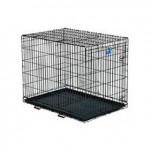Archive for the ‘essentials’ Category
10 Tips For Your New Puppy
Willow‘s puppies all went home today with their new forever families. Here are tips for all families that bring home a new puppy:
 Limit the number of rooms the puppy/dog has access to for the first week or so.
Limit the number of rooms the puppy/dog has access to for the first week or so.- Limit the amount of “attention” you give the new member of your family for the first few days…let them get acclimated a bit.
- Place the crate in a bedroom for the first few nights or sleep next to the crate. Remember, all the puppies slept lumped together, spending the night alone will really be scary and having you nearby will greatly help.
- Unless you want a dog that whines in her crate, do not let her out when she is crying/whining/pawing or barking. Wait until she quiets and then let her out. To avoid this, set an alarm for every 3 or 4 hours that first night and wake her up to take her potty. Soon you will be able to cut out those middle of the night potty breaks but if you do this for that first few nights (first week?) it will really pay off. The alternative, letting the dog wake you up can lead to reinforcing whining and barking in the crate. We don’t want that!
 Take your new family member to the same spot in the yard every time he transitions to a new activity (or every hour or two) and tell him “go potty” or some such command. If nothing happens in a few minutes, come back inside.
Take your new family member to the same spot in the yard every time he transitions to a new activity (or every hour or two) and tell him “go potty” or some such command. If nothing happens in a few minutes, come back inside.- Watch for nervous behavior, circling and sniffing the ground, whining – these are cues that your puppy needs to poop.
- You have 3 seconds to reward or correct a behavior! That’s it! So, unless you catch the puppy in the act of peeing, scolding him will only make him afraid of you. If you miss it, let it go and commit to being more attentive in the future.
- Your puppy won’t need a real walk until they are about 4 months of age but do get them used to their leash and collar by putting them on and walking around the yard and house.
- Remember: these guys (Willow included) are like blank slates…they will learn what you teach them or let them do regularly. Be mindful not to condition them to expect behavior that you won’t want a full grown dog to do. A good example, letting them pull you to the door. As anxious as you are to get the out to potty, try to keep good leash manners in front of your mind. Walk to the door with the dog/pup at you side or behind you. Go out the door first, then the pup/dog. Once outside, give a command word as you walk to your potty spot and then let them have full reign of the leash. Otherwise, you are teaching a dog to pull on leash while you are house training it!
 Remember to love them up good but don’t “cut them slack” – keep in mind the behavior you want and reinforce it (with cuddles, praise and treats) and ignore or correct (NOT PUNISH – just make a disapproving sound – I like AH!) behavior you don’t want. They will appreciate the clarity.
Remember to love them up good but don’t “cut them slack” – keep in mind the behavior you want and reinforce it (with cuddles, praise and treats) and ignore or correct (NOT PUNISH – just make a disapproving sound – I like AH!) behavior you don’t want. They will appreciate the clarity.
Cherish your new family member!
What to feed puppies
The puppy appointments went well today! I really liked all the people I met (thank goodness!) and feel good about them. The puppies had a full day of outside time meeting everyone. I also introduced them to water (a small pool) and no one was very interested in it…except Ash. He sort of took to it. If someone out there is interested in a water loving dog, he’d be the best shot in this group…and what a sweetie. Anyone??
Here’s a question I got from one of my new families and my response:
1. I’m reading so many different things about what to feed puppies and I wanted to get your opinion. Soft, hard, mixed? what brand?
In terms of feeding – I like feeding dry (hard) food as it is the most cost effective and it helps clean the teeth better than wet food. I am also a big fan of brushing your dog’s teeth (with dog toothpaste only, but a human tooth brush is fine – get an “enzymatic” toothpaste either from a pet superstore or the vet.) Brands vary so educate yourself…stay away from “by products” or “animal fat”…if you don’t know what it is you shouldn’t be feeding it to your dog!
I feed my dogs Canidae and if I didn’t feed that I’d feed Natural Balance – both good foods. Nutro makes a good brand, but one of my dog’s has an allergic (skin) reaction to it. Stay away from “puppy chow”” or anything you can buy in the grocery store…unfortunately. You will pay more for the good stuff but you will feed smaller portions (compare feeding portions – they vary wildly…a poor quality food will require up to 7 cups to get the same nutritional value as 2 cups of a high quality food.) In addition, feeding smaller portions means a smaller stool size – something to really shoot for with the big dogs!
Canidae All Life Stages Dry Dog Food 35 lb. Bag
Natural Balance Potato & Duck Dog Food Allergy Formula 17 lb. Bag
Heartgard best for heartworm protection
Hopefully you read my post on the merits of Frontline Plus and how to save a few dollars in the process. Ok, now a word on heartworm preventative…
If you live anywhere where there aren’t hard, killing frosts, you have no business stopping your heartworm preventative! Let me repeat: Treat your pet every singe month with a heartworm preventative if you live anywhere where some plants can survive all winter. Here in Illinois everything dies back or goes dormant for at least three months of the year: December, January, and February and these are the months that I stop heartworm treating my dogs. But this is the first time every that I did not treat for the full 12 months. Again, the reason I stopped was to try to save some money and it felt safe to me. But heartworm is a NASTY parasite and it will kill your dog. Don’t mess around. Prevention is easy but not all products are created equal.

I have been treating my pets (Cleo the cat and all my dogs) for the past 20 some years with Heartgard. The dogs LOVE the meaty chew and even our nearly 15 year old gobbles it up. It is never difficult to get the medication into the dogs. But you have to have your vet’s prescription to purchase the medication so I always just bought it from my vet. However, last year I tried two things. First I shopped online and found that the same products were slightly cheaper on PetMeds.com than at my vet. Second, I tried Interceptor. Shopping at PetMeds was a GOOD idea, switching products was not. See, I like Heartgard because it is easy to get the correct dose into my dogs and that dose covers other parasites as well; parasites like round worm and others. Interceptor says it covers other parasites too but the product comes in a hard tablet form and my dogs either swallowed it whole (the package said they were supposed to chew it for it to be effective) or refused to eat it. So I was forced to either jam it down their throats (which I did one month) or grind it up and mix it with some wet food – which was WAY more hassle than I wanted.
Frontline Plus is best for fleas and ticks
If you are like me, and live in a part of the world with four seasons you get to take a break from your flea and tick preventative. I stop treating my dogs after the first few hard frosts, usually sometime in late November or early December. But then, as spring approaches, I have to check my supplies. I try to keep enough on hand for at least one treatment in the spring before ordering my next years supply.
 I used to purchase my favorite preventative, Frontline Plus, from my veterinarian when I got my heartworm preventative. But with four dogs and the tightening of our belts this past year, I started doing some research to see where I could find the best deals. And I was shocked to find Frontline Plus online through Amazon for nearly half the cost of what my veterinarian was charging. I have heard rumors that the products on Amazon aren’t as high quality as the ones you get through the vet’s office but I find that hard to believe. It says Frontline Plus on the package, looks exactly like the packaging I get through the vet’s office, and works perfectly. I think the people who don’t trust it when bought online are just new to our online, global market place.
I used to purchase my favorite preventative, Frontline Plus, from my veterinarian when I got my heartworm preventative. But with four dogs and the tightening of our belts this past year, I started doing some research to see where I could find the best deals. And I was shocked to find Frontline Plus online through Amazon for nearly half the cost of what my veterinarian was charging. I have heard rumors that the products on Amazon aren’t as high quality as the ones you get through the vet’s office but I find that hard to believe. It says Frontline Plus on the package, looks exactly like the packaging I get through the vet’s office, and works perfectly. I think the people who don’t trust it when bought online are just new to our online, global market place.
Here’s why I like Frontline Plus so much:
(more…)
Bringing home a new puppy

This is Ebbie
My sister lives in California and is feeling ready to invite a dog into her life. She found this little guy, Ebbie. Here’s a link to his rescue organization.
Anyway, as we were talking I told her the advice I tell all new dog owners. And this applies to you whether you are adopting a rescue dog, a rescue puppy, buying a pet store dog/puppy (but you wouldn’t do that now would you?) or buying from a breeder:
First, bring your dog home and give him a walk around your neighborhood. For a small dog it can be a small dog walk – around 30 minutes. For a larger breed, a larger walk, at minimum an hour, better to be longer. Keep the walk controlled meaning the dog should be at your side or behind you. Remind him of his place as often as necessary, either by a gentle tug on the leash and a correction word/sound, or by stopping in your tracks whenever he starts to pull on the leash. If this doesn’t get his attention (more…)
Crating Your Dog
 Crates are not bad as some people say – they replicate the idea of a den which dogs naturally dig in the wild. However, no den that they dig includes a door they can’t open. Don’t believe people who say that dogs “love” their crates. No animal likes to be confined against its will. But many dogs learn to tolerate their crates and will go in willingly when asked. Some even go to them when they are tired on their own. But when we shut that door we take away their freedom and they know it. They comply because that is what makes them the amazing creatures they are – they trust us implicitly.
Crates are not bad as some people say – they replicate the idea of a den which dogs naturally dig in the wild. However, no den that they dig includes a door they can’t open. Don’t believe people who say that dogs “love” their crates. No animal likes to be confined against its will. But many dogs learn to tolerate their crates and will go in willingly when asked. Some even go to them when they are tired on their own. But when we shut that door we take away their freedom and they know it. They comply because that is what makes them the amazing creatures they are – they trust us implicitly.





